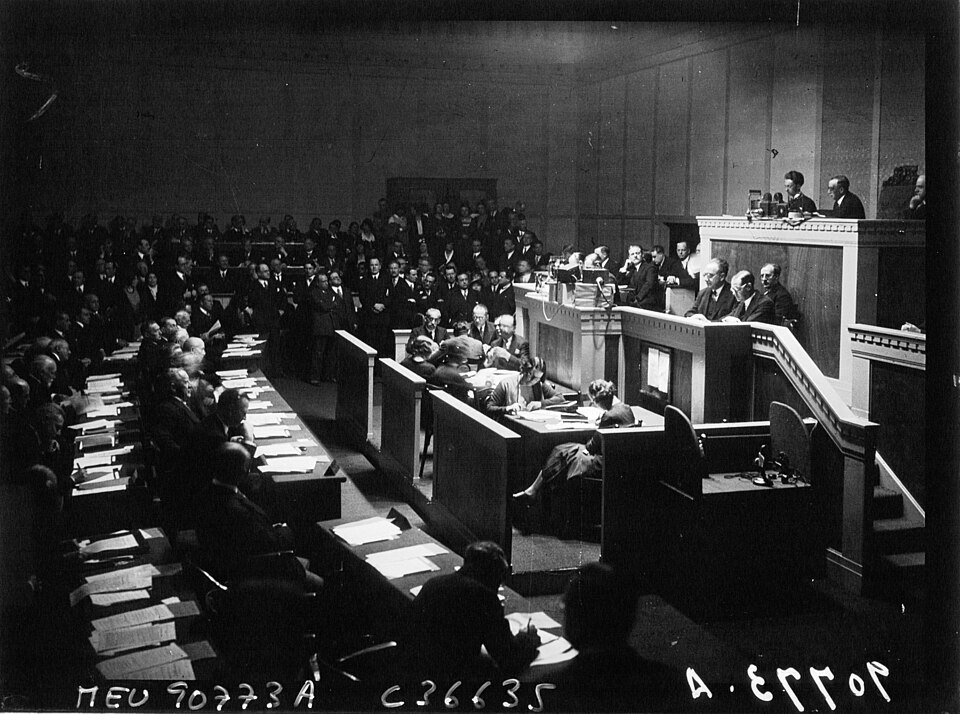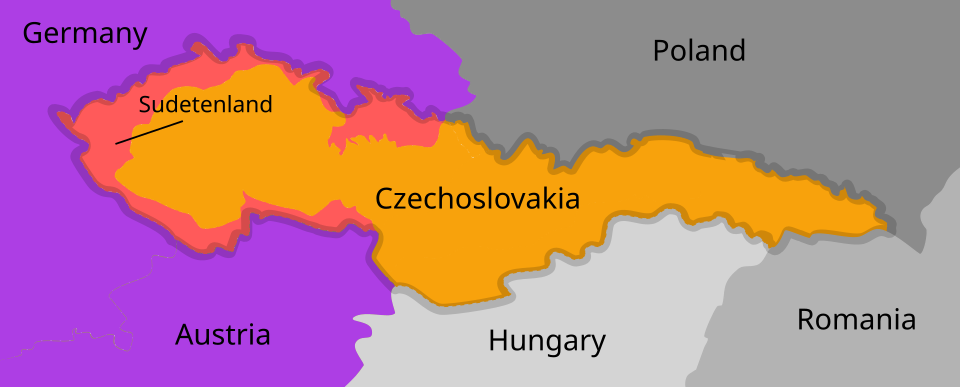IB Syllabus focus:
'The breakdown of post-WWI collective security arrangements.
Major diplomatic alignments of the period and their implications for European stability.
The policy of appeasement: reasons, key events, and its role in facilitating expansion.'
Post-World War I Europe was a complex tapestry of political manoeuvres, treaty obligations, and strategic considerations. Central to this era was the dance of diplomacy and the shadow of appeasement.
Breakdown of Post-WWI Collective Security Arrangements
World leaders wanted to prevent a recurrence of the horrors of WWI. Thus, they sought a system wherein nations would cooperate to ensure mutual security.
The League of Nations
Foundation: The League was established in 1920, under the Treaty of Versailles, with the primary aim of maintaining world peace through collective security and diplomacy.
Failures: Despite its noble intent, by the 1930s, the League faced existential challenges. The absence of major powers like the US, and the departure of nations such as Japan in 1933 and Germany in 1935, weakened its influence.
Inefficacy in Crises: The League’s inability to prevent Italy's invasion of Abyssinia (1935) and Japan's invasion of Manchuria (1931) showcased its limitations.
Disarmament Efforts
Geneva Disarmament Conference (1932-1934): A significant endeavour to reduce global armaments. However, German demands for parity in armaments led to disputes, resulting in the conference's failure.

Arthur Henderson addresses delegates at the 1932 World Disarmament Conference in Geneva, convened under League auspices to curb armaments after WWI. Despite broad participation, deep disagreements over parity and verification doomed the effort, undermining collective security. Source
Impact: The inability to achieve disarmament resulted in distrust. As nations accelerated their rearmament, the stage was set for a major conflict.
Major Diplomatic Alignments of the Period
In an atmosphere rife with uncertainty, nations sought security in alliances. These alliances reflected not just mutual interests, but also shared concerns about potential adversaries.
Franco-Soviet Treaty of Mutual Assistance (1935)
Backdrop: With Germany's rearmament and departure from the League of Nations, both France and the Soviet Union felt threatened.
Contents: The treaty was essentially defensive. However, it had a significant psychological and strategic value.
Implications: Britain's reluctance to commit to such alignments highlighted its hope for a diplomatic solution with Germany, leaving France feeling isolated.
Anglo-German Naval Agreement (1935)
Context: This agreement permitted Germany to construct a navy, with restrictions on its size relative to the British fleet.
Implications: While Britain viewed this as a measure to maintain a balance of power, it effectively undermined the Treaty of Versailles. It was a significant diplomatic victory for Hitler.
Anti-Comintern Pact (1936)
Partners: Initially between Germany and Japan, Italy joined later.
Objective: Ostensibly against the communist threat, but in reality, it was an anti-Soviet pact.
Repercussions: This pact hinted at the forming Axis alliance, which would come to challenge the established world order.
The Policy of Appeasement
Appeasement, primarily associated with Britain and France, was a policy of making political or material concessions to an aggressive power to avoid conflict.
Reasons for Appeasement
Memories of WWI: The devastating loss of life and infrastructure during WWI made leaders, especially in Britain, reluctant to confront another war.
Economic Constraints: The Great Depression meant countries, especially Britain and France, were preoccupied with domestic economic challenges.
Misjudgment of Hitler: Many leaders believed Hitler's grievances were legitimate and once addressed, he would become more conciliatory.
Distrust of the Soviet Union: Fascist expansion was often viewed as a lesser evil compared to the spread of Bolshevism.
Key Events in Appeasement
Rhineland (1936): Germany's reoccupation of the Rhineland was a bold move. It was a clear violation of the Treaty of Versailles. However, Britain and France, prioritising their own strategic interests and a desire to avoid conflict, did not act.
Anschluss with Austria (1938): This was another blatant violation of treaties. Yet, the international response was marked by resignation rather than resistance.
Munich Agreement (1938): In a bid to avoid war, Britain and France agreed to Germany's annexation of the Sudetenland. It was hailed by Chamberlain as "peace for our time", but it only emboldened Hitler further.

Map showing the Sudetenland areas transferred to Germany in late 1938 under the Munich Agreement. The clear color blocks and labels help visualize the territorial change that followed diplomatic concessions. Source
Appeasement’s Role in Facilitating Expansion
Green Light for Aggression: By not responding to early acts of German expansion, appeasement inadvertently encouraged further German ambitions.
Moral Argument: Critics argue that appeasement, especially at Munich, was not just a strategic blunder but a moral failure, as it betrayed Czechoslovakia.
Strategic Implications: The policy gave Germany the time to consolidate its gains and continue its rearmament, making eventual conflict even more devastating.
The diplomatic alignments and the policy of appeasement of the 1930s profoundly shaped the course of history. They offer a rich tapestry of lessons on the interplay of strategy, morality, and realpolitik in international relations.
FAQ
The Great Depression, which began in 1929 and lasted throughout the 1930s, had a profound influence on the policy of appeasement. As economies crumbled and unemployment soared, many nations, including Britain and France, became increasingly introspective. The urgent need to address domestic economic hardships took precedence over international issues. Given the pressing economic challenges, neither country was keen on investing in military confrontations or risking further economic destabilisation. The mood of the populace, weary from economic hardship, was against war. This economic backdrop made appeasement seem like an attractive option, as it promised a path of least resistance, even in the face of growing territorial ambitions by fascist powers.
The failure of the Geneva Disarmament Conference (1932-1934) had profound implications. It was meant to foster a sense of collective security by ensuring mutual disarmament, thereby reducing the threat of future conflicts. However, its failure sowed seeds of distrust among nations. As countries like Germany, led by the Nazis, started to rearm at an alarming pace, others followed suit, believing they had to ensure their own safety. This arms race not only heightened tensions but also meant that when conflict did eventually break out, it was on a much larger and more devastating scale. The failure symbolised the broader decline of cooperative internationalism during the 1930s.
The Anti-Comintern Pact, initially signed between Germany and Japan in 1936 and later joined by Italy, was presented as a bulwark against the international spread of communism, specifically targeting the Communist International (Comintern). However, its underlying intent was transparently anti-Soviet. The Comintern, based in Moscow, was perceived as a tool of Soviet foreign policy. By aligning against it, the signatories were indirectly opposing the USSR. The pact not only symbolised the mutual apprehensions the signatories had regarding the Soviet Union but also hinted at the potential formation of a united front against Moscow, deepening the divides in the geopolitical landscape of the 1930s.
The international community's perception of the Soviet Union in the 1930s was tinged with suspicion and wariness. The spread of communism was feared by many Western powers, and the USSR's overtly stated goal of promoting global proletarian revolutions did little to ease those concerns. The purges and show trials under Stalin raised serious questions about the nature of the Soviet regime. Additionally, the Soviet Union's rapid industrialisation and its growing military might made it a significant power, but its intentions were unclear. Although France sought to align with the USSR as a counter to German resurgence, Britain and other nations were more hesitant, often viewing the Soviet Union as a wild card in European geopolitics.
Britain's stance on the remilitarisation of the Rhineland was largely passive, rooted in a combination of domestic factors and foreign policy considerations. Many in Britain viewed the Treaty of Versailles as overly punitive and believed that Germany had a legitimate right to station troops within its own borders. Furthermore, the memories of the colossal devastation of WWI and the severe economic challenges posed by the Great Depression made Britain exceedingly wary of any confrontation. The prevalent mood was to avoid another conflict at all costs. Additionally, there was a belief in some quarters that a resurgent Germany could act as a buffer against the perceived threat of Soviet communism.
Practice Questions
The policy of appeasement, chiefly adopted by Britain and France, played a pivotal role in escalating tensions in Europe during the 1930s. This policy, rooted in the traumas of WWI and economic hardships of the 1930s, led to significant concessions to aggressive powers, especially Germany. By not confronting early German violations like the reoccupation of the Rhineland and the Anschluss with Austria, appeasement emboldened Hitler's expansionist ambitions. The Munich Agreement of 1938 is emblematic of appeasement's failure, as it not only sacrificed Czechoslovakia but also gave Germany a strategic advantage, making future conflicts in Europe almost inevitable.
The 1930s witnessed a series of diplomatic alignments that encapsulated the shifting power dynamics in Europe. The Franco-Soviet Treaty of Mutual Assistance in 1935 highlighted France's apprehensions about German resurgence and the need to hedge against potential threats. In contrast, the Anglo-German Naval Agreement the same year illustrated Britain's approach to maintaining a balance of power, even at the expense of undermining the Treaty of Versailles. Meanwhile, the Anti-Comintern Pact initiated by Germany and Japan, later joined by Italy, hinted at the formation of the Axis powers. These alignments mirrored the anxiety, miscalculations, and strategic plays of the era, culminating in a fragile and volatile European landscape.

